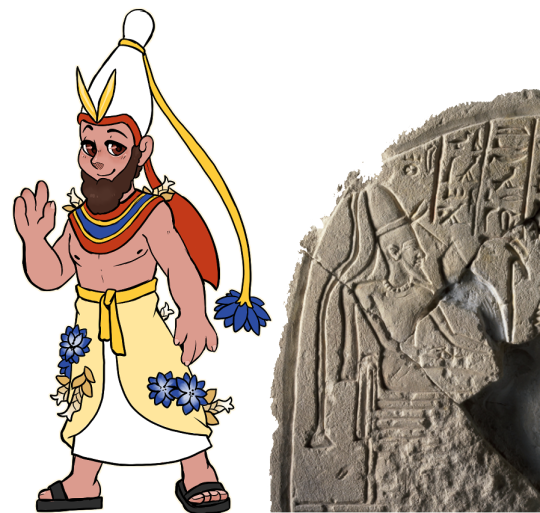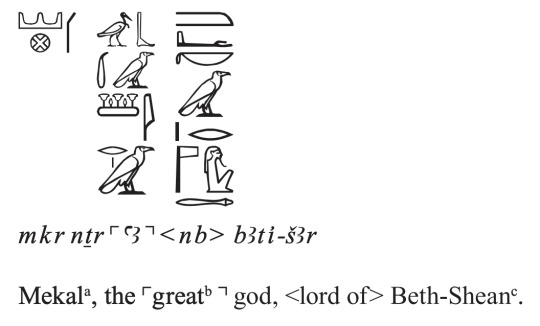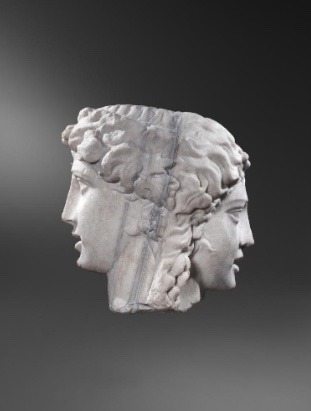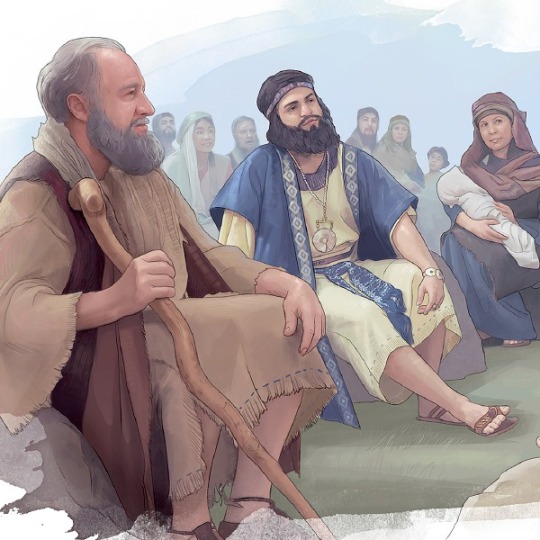#beth-shean
Explore tagged Tumblr posts
Text

Mekal (or Mekar), the lord of Beth-Shean
I strongly hold that the Baal Cycle is not "Canaanite mythology." The Ugarites themselves identified Canaanites as "foreign people," and Mot, in particular, is strongly suspected to be a literary invention of Ilumilku, the scribe who wrote the Baal Cycle. To subsume the myths under the vague title of 'Canaanite mythology' is a disservice to Ugarit and its creativity, in my opinion.
So that naturally brought a question to mind: are there any Bronze Age deities who are distinctly Canaanite?
Enter Mekal/Mekar. A Fresh Look at the Mekal Stele (Levy 2018) introduces us to a deity who was attested in northern Palestine during the Bronze Age.

(Levy 2018: 361)
That "r" at the end of his name can be either an "r" or a Semitic "l", hence the Mekal/Mekar options for his name. And he's attested as the lord of Beth-Shean (or Bit-Shani, if you fancy the syllabic Akkadian transcription). How cool is that?
Some thoughts about this deity: his iconography is closely aligned with Baal's known iconography from the time period (which should make one wonder if there isn't some possible synchronization afoot, as if Seth-Baal wasn't strong enough evidence, lol), with one caveat: he has Resheph's headband. So some differences!
What I draw from that is Mekal/Mekar is a Baal-like deity but with some differences. In the Pantheon universe, thus, Mekal is primarily a vegetation god with some rain-bringing abilities, not a storm god proper. He doesn't have the weather manipulation capability that Baal does, but he's good at making flowers and helping agriculture grow!
Given the strong Egyptian influence here, Mekal strikes me as the type who really likes lotuses, too. Maybe he really looks forward to the few visits that Nefertem makes in the foreign northern lands? Well, assuming Sekhmet's willing to let him out...
Anyway, Beth-Shean is a major Egyptian administrative center in the Late Bronze Age, so Sutekh likely stops in Beth-Shean often before continuing onward to Gubla (Byblos), another Egyptian holding. Mekal, with his minimal attestation, seems like a very young god (and it's suspicious that he's not attested afterward). Perhaps he was educated in Kemet as a godling and then brought back to Beth-Shean to rule it, as the Egyptians were known for doing with foreign princes. Couldn't get him to get rid of the beard, though. Some cultural influences refuse to die.
Artwork commissioned from Eaglidots
#canaanite mythology#canaanite deity#canaanite god#mekal#mekar#beth-shean#mekal stele#pantheon#bronzegods#bronze gods#don't we love obscure deities#I sure love them because I want to populate the story's world with more than just the most well known deities#lore#amorite-mythology#perhaps… Amorite is the precursor to Hebrew#iconography
10 notes
·
View notes
Photo



The 'Beth Shean' Marble Bust 2nd-3rd century AD H. 47.5 x w. 32 x d. 41 cm
A monumental marble janiform herm of marmo lunense marble depicting the heads of Bacchus and Ariadne. Bacchus wears a fillet across his forehead, the centrally parted hair dressed with a rich garland of ivy leaves with two frontal clusters of berries, vine leaves, and bunches of grapes hanging behind the ears. Ariadne has softer features and a fuller face, her wavy hair is also centrally parted and dressed with delicate ivy berries and leaves.
#The 'Beth Shean' Marble Bust#2nd-3rd century AD#marble#marble bust#marble statue#ancient artifacts#archeology#archeolgst#history#history news#ancient history#ancient culture#ancient civilizations#ancient rome#roman history#roman empire#roman art
79 notes
·
View notes
Text
JEZREEL VALLEY REGIONAL PROJECT
Excavation WebSite Ratings 1/?
https://www.jezreelvalleyregionalproject.com/
MANAGEABILITY: 10/10
This was the first website I pulled up that had a current excavation, and its genuinely easy explore.
CURRENCY: 7/10
There is an excavation form available for this summer and its easy to find. They also have an automatically updating news page! However, there are parts of the website that still have the wrong dates and group names.
AESTHETICS: 9/10
A beautiful design. The only hiccup is some of the photos of the staff are blurry and the news outlet colors make the contrast too hard to read. However, the backdrop and the title page are beautiful. I could watch the drone footage on loop for hours.
CREATIVITY: 8/10
The introduction video to the dig on the volunteer page is very well shot and moving! :D (although I am unsure of why a random photo of Beth Shean was inserted in there lol). However, there is no content available on the “blog” section of the site, and there could definitely be a place to access photos. It just doesn’t WOW me.
SINCERITY: 10/10
The videos made it really clear that there is a lot of hard physical labor in excavation as well as early hours. It takes up a lot of brain and muscle power, but its enthralling! They’re able to be honest and still show how people like me keep at it. ROMANTICIZATION AT ITS FINEST
FINAL SCORE: 9/10!
They wanna teach volunteers and students and lead people to uncovering some awesome ancient stuff, we love to see it!
WOULD I GO? - Of course!! The Jezreel Valley is a beautiful place, and this excavation looks modest but still enthralling... I would be proud to work alongside them.
#jezreel valley regional project#jvrp#archaeology#excavation website ratings#dig sites#jezreel valley#legio#megiddo
3 notes
·
View notes
Text
Galyn's Israel Photos

Sites in Israel: 0. Sea of Galilee 1. Dan 2. Caesarea Philippi 3. Hazor 4. Qasrin/Katzrin 5. Capernaum 6. Bethsaida 6. Geshur 7. Korazin 8. Caves of Arbel 9. En Gev 10. Sepphoris 11. Nazareth 12. Elijah's Altar on Mt. Carmel 13. Jezreel Valley 14. Megiddo 14. Jezreel 15. En Harod 16. Beth Shean 17. Caesarea 18. Shiloh 19. Gezer 20. Gibeon (same as #21) 20. Gibeah of Saul 20. Geba 21. Nabi Samwil (a High Place)Between 17 & 27- Joppa/Tel AvivNear Jerusalem Beth Horon Pass Near Jerusalem - NOB Near Jerusalem - Bethany 22. Jericho 23. Qumran 24. Bethlehem 25. Beth Shemesh 26. Elah Valley, Socoh 26. Azekah 26. Khirbet Qeiyafa 27. Bet-Guvrin (Mareshah) 27. Ashkelon 27. Besor, Wadi Besor 28. Gath 28. Lachish 29. Herodion 30. Dead Sea 31. En Gedi 32. Masada 33. Arad 34. Beersheba 35. Avdat 36. Mitzpe Ramon 37. Mediterranean Sea


1 note
·
View note
Text
ok yeah fine. i did spend literal hours going down a rabbithole about depictions of beribboned parrots in the 6th century levant (antioch and also what's currently beth shean) and i AM somewhat disappointed that it seems to be imagery borrowed from the Sassanids and not likely indicative of ancient pet fashions. you have noo idea how many unlabeled stupid gd pictures i googled lensed and/or guessed the location of based on similarity to properly labeled images and well i simply hoped for something more exciting than this. not sure what but yeah.

1 note
·
View note
Text

N'acceptez rien de moins que le meilleur de Dieu
Manassé ne chassa pas les habitants de Beth-Shean, Thaanac, Dor, Jibleam, Meguiddo et des villes qui en dépendaient. Les Cananéens voulurent rester dans ce pays.
Juges 1.27
Les Israélites avaient traversé le Jourdain pour entrer en Terre promise. Avant cela, chaque tribu avait reçu un territoire à posséder. Certaines avaient établi un contrôle ferme, mais plusieurs tribus n'ont pas réussi à conquérir leurs terres. Ainsi, elles n'ont jamais connu la pleine victoire que Dieu avait prévue pour elles.
Dieu avait averti les Israélites qu'ils devaient chasser les habitants du pays, sinon ils seraient "un filet et un piège". Bien que Dieu leur ait déjà donné le pays (Josué 23.13), ces Israélites n'avaient ni la foi ni la détermination nécessaires pour croire en la victoire divine.
De nombreux chrétiens sont comme ces Israélites. Dieu leur a donné sa Parole, pleine de puissance et de sagesse. Il a envoyé Jésus mourir pour eux et leur donner l'autorité sur l'ennemi. Il a envoyé son Esprit pour être leur conseiller. Pourtant, beaucoup ne parviennent pas à connaître la victoire, se contentant d'accepter une vie pleine de compromis, pris au piège des choses de ce monde.
Aujourd'hui, souvenez-vous que Dieu vous a déjà donné tout ce dont vous avez besoin pour remporter la victoire dans tous les domaines de votre vie ; mais il vous donne aussi la possibilité de décider comment réagir.
Ne négligez pas la victoire qu'il a préparée pour vous ! Confiez-lui votre vie : chaque situation, chaque besoin, chaque problème. Étudiez sa Parole et mettez-la en pratique. Ayez la foi et croyez en sa protection, sa puissance, sa direction et sa sagesse.
Ne laissez pas le monde être un piège et n'acceptez rien de moins que le meilleur de Dieu. Il vous a déjà donné la victoire. Avancez avec assurance !
John Roos
0 notes
Text


Byzantine lion and zebra mosaics at the site of Beth She’an.
163 notes
·
View notes
Text
II Samuel 21:12
The streets of Beth-Shan
decorated with Saul's bones
accursed their designers.
D W Eldred
7 notes
·
View notes
Text
hello!
Sorry I haven’t been active in the past several weeks, I’ve been in Israel as part of an archaeology field school in Huqoq and the internet connection is terrible. I’ll be back home by early July so I promise to post when I get back!
In the mean time, here’s some photos from our trip to Beth Shean yesterday:



113 notes
·
View notes
Text
Homeric Hymn 11, "To Athena"
Of Pallas Athena, city-protector, I commence to sing – A dread goddess, who, along with Ares, Concerns herself with works of war, With cities sacked, with battle-cries and clashes: When the host goes forth And when they return, she guards them. Hail, goddess; give us luck and happiness. Παλλάδ᾽ Ἀθηναίην ἐρυσίπτολιν ἄρχομ᾽ ἀείδειν, δεινήν, ᾗ σὺν Ἄρηι μέλει πολεμήια ἔργα περθόμεναί τε πόληες ἀϋτή τε πτόλεμοί τε, καί τ᾽ ἐρρύσατο λαὸν ἰόντα τε νισσόμενόν τε. χαῖρε, θεά, δὸς δ᾽ ἄμμι τύχην εὐδαιμονίην τε.

Athena. Head from a statue (Thasian marble) by an unknown artist, probably 2nd cent. CE. Found at Tel Naharon (modern Beth Shean), Israel; now in the Israel Museum, Jerusalem. Photo credit: Carole Raddato.
#classics#tagamemnon#Greek#Ancient Greek#Ancient Greece#poem#poetry#translation#poetry in translation#Greek poetry#Ancient Greek poetry#hymn#Homeric Hymns#classical mythology#Greek religion#Ancient Greek religion#Hellenic polytheism#Athena
127 notes
·
View notes
Text
Issachar’s Descendants

1 Issachar’s four sons were Tola, Puah, Jashub, and Shimron. 2 Tola’s sons were Uzzi, Rephaiah, Jeriel, Jahmai, Ibsam, and Shemuel. These men were heads of the families of Tola. They were soldiers grouped according to their ancestry. In David’s day there were 22,600 of them. 3 The five descendants of Uzzi were Izrahiah and Izrahiah’s sons Michael, Obadiah, Joel, and Isshiah. All of them were heads of families. 4 They had many wives and children. So in addition to these men grouped according to their ancestry and families, there were 36,000 soldiers. 5 Their relatives (that is, all of Issachar’s families) were fighting men. A total of 87,000 of them was recorded in the genealogy.
Benjamin’s Descendants
6 Benjamin had three sons: Bela, Becher, and Jediael. 7 Bela’s five sons were Ezbon, Uzzi, Uzziel, Jerimoth, and Iri. They were heads of families and fighting men. In the genealogy 22,034 of them were recorded. 8 Becher’s sons were Zemirah, Joash, Eliezer, Elioenai, Omri, Jeremoth, Abijah, Anathoth, and Alemeth. These were all of Becher’s sons. 9 In the genealogy 22,200 of them were recorded according to their ancestry (the heads of their families and fighting men). 10 Jediael’s son was Bilhan. Bilhan’s sons were Jeush, Benjamin, Ehud, Chenaanah, Zethan, Tarshish, and Ahishahar. 11 All of these men were Jediael’s descendants. They headed families that produced 17,200 fighting men who could go to war. 12 The Shuppites and Huppites were Ir’s descendants. The Hushites were descendants of someone else.
Naphtali’s Descendants
13 Naphtali’s sons were Jahziel, Guni, Jezer, and Shallum. They were Bilhah’s grandsons.
Manasseh’s Descendants Who Lived West of the Jordan River
14 Manasseh’s sons were Asriel and Machir. Their mother was Manasseh’s Aramean concubine. Machir was the first to settle Gilead. 15 He married a wife from the Huppites and Shuppites. His wife’s name was Maacah. The name of his second son was Zelophehad. Zelophehad had only daughters. 16 Maacah, Machir’s wife, had a son, and she named him Peresh. His brother’s name was Sheresh, whose sons were Ulam and Rakem. 17 Ulam’s son was Bedan. These were the people of Gilead, descendants of Machir (son of Manasseh). 18 Bedan’s sister Hammolecheth gave birth to Ishhod, Abiezer, and Mahlah. 19 Shemida’s sons were Ahian, Shechem, Likhi, and Aniam.
Ephraim’s Descendants
20 Ephraim’s son was Shuthelah. Shuthelah’s son was Bered. Bered’s son was Tahath. Tahath’s son was Eleadah. Eleadah’s son was Tahath. 21 Tahath’s son was Zabad. Zabad’s son was Shuthelah.
Ephraim’s sons Ezer and Elead were killed by the men of Gath when they came to take their livestock. 22 Their father Ephraim mourned a long time, even though his brothers tried to comfort him. 23 Then he slept with his wife, and she became pregnant. She gave birth to a son, and Ephraim named him Beriah [Tragedy], because tragedy had come to his home. 24 Beriah’s daughter was Sheerah, who built Upper and Lower Beth Horon and Uzzen Sheerah. 25 Beriah’s son was Rephah. Rephah’s son was Resheph. Resheph’s son was Telah. Telah’s son was Tahan. 26 Tahan’s son was Ladan. Ladan’s son was Ammihud. Ammihud’s son was Elishama. 27 Elishama’s son was Nun. Nun’s son was Joshua.
28 The land and homes of Ephraim’s descendants were in Bethel and its villages, Naaran to the east, Gezer with its villages to the west, Shechem and its villages, and as far as Gaza and its villages. 29 Next to Manasseh were Beth Shean and its villages, Taanach and its villages, Megiddo and its villages, and Dor and its villages. The descendants of Joseph, son of Israel, live in these cities.
Asher’s Descendants
30 Asher’s sons were Imnah, Ishvah, Ishvi, and Beriah. Their sister was Serah. 31 Beriah’s sons were Heber and Malchiel, who first settled Birzaith. 32 Heber was the father of Japhlet, Shomer, Hotham, and their sister Shua. 33 Japhlet’s sons were Pasach, Bimhal, and Ashvath. These were Japhlet’s sons. 34 The sons of his brother Shomer were Rohgah, Jehubbah, and Aram. 35 His brother Helem’s sons were Zophah, Imna, Shelesh, and Amal. 36 Zophah’s sons were Suah, Harnepher, Shual, Beri, Imrah, 37 Bezer, Hod, Shamma, Shilsha, Ithran, and Beera. 38 Jether’s sons were Jephunneh, Pispa, and Ara. 39 Ulla’s sons were Arah, Hanniel, and Rizia. 40 All of these men were Asher’s descendants—heads of their families, outstanding men, soldiers, and distinguished leaders. Their military roster had 26,000 recorded in it. — 1 Chronicles 7 | Names of God Bible (NOG) The Names of God Bible (without notes) © 2011 by Baker Publishing Group. Cross References: Genesis 22:24; Genesis 25:20; Genesis 46:13; Genesis 46:17; Genesis 46:21; Genesis 46:24; Genesis 50:23; Exodus 17:9; Exodus 24:13; Numbers 1:10; Numbers 26:35-36; Numbers 26:48-49; Numbers 31:38; Joshua 16:2-3; Joshua 16:5; Judges 1:22; Judges 20:15; 2 Samuel 24:1; 1 Kings 22:11; 1 Chronicles 5:24; 1 Chronicles 8:1; John 11:19
#Issachar#Benjamin#Naphtali#Manasseh#Ephraim#Asher#descendants#genealogy#1 Chronicles 7#Book of First Chronicles#Old Testament#NOG#Names of God Bible#Baker Publishing Group
8 notes
·
View notes
Text
1 Kings 4
Solomon’s Officials
[1] King Solomon was king over all Israel, [2] and these were his high officials: Azariah the son of Zadok was the priest; [3] Elihoreph and Ahijah the sons of Shisha were secretaries; Jehoshaphat the son of Ahilud was recorder; [4] Benaiah the son of Jehoiada was in command of the army; Zadok and Abiathar were priests; [5] Azariah the son of Nathan was over the officers; Zabud the son of Nathan was priest and king’s friend; [6] Ahishar was in charge of the palace; and Adoniram the son of Abda was in charge of the forced labor.
[7] Solomon had twelve officers over all Israel, who provided food for the king and his household. Each man had to make provision for one month in the year. [8] These were their names: Ben-hur, in the hill country of Ephraim; [9] Ben-deker, in Makaz, Shaalbim, Beth-shemesh, and Elonbeth-hanan; [10] Ben-hesed, in Arubboth (to him belonged Socoh and all the land of Hepher); [11] Ben-abinadab, in all Naphath-dor (he had Taphath the daughter of Solomon as his wife); [12] Baana the son of Ahilud, in Taanach, Megiddo, and all Beth-shean that is beside Zarethan below Jezreel, and from Beth-shean to Abel-meholah, as far as the other side of Jokmeam; [13] Ben-geber, in Ramoth-gilead (he had the villages of Jair the son of Manasseh, which are in Gilead, and he had the region of Argob, which is in Bashan, sixty great cities with walls and bronze bars); [14] Ahinadab the son of Iddo, in Mahanaim; [15] Ahimaaz, in Naphtali (he had taken Basemath the daughter of Solomon as his wife); [16] Baana the son of Hushai, in Asher and Bealoth; [17] Jehoshaphat the son of Paruah, in Issachar; [18] Shimei the son of Ela, in Benjamin; [19] Geber the son of Uri, in the land of Gilead, the country of Sihon king of the Amorites and of Og king of Bashan. And there was one governor who was over the land.
Solomon’s Wealth and Wisdom
[20] Judah and Israel were as many as the sand by the sea. They ate and drank and were happy. [21] Solomon ruled over all the kingdoms from the Euphrates to the land of the Philistines and to the border of Egypt. They brought tribute and served Solomon all the days of his life.
[22] Solomon’s provision for one day was thirty cors of fine flour and sixty cors of meal, [23] ten fat oxen, and twenty pasture-fed cattle, a hundred sheep, besides deer, gazelles, roebucks, and fattened fowl. [24] For he had dominion over all the region west of the Euphrates from Tiphsah to Gaza, over all the kings west of the Euphrates. And he had peace on all sides around him. [25] And Judah and Israel lived in safety, from Dan even to Beersheba, every man under his vine and under his fig tree, all the days of Solomon. [26] Solomon also had 40,000 stalls of horses for his chariots, and 12,000 horsemen. [27] And those officers supplied provisions for King Solomon, and for all who came to King Solomon’s table, each one in his month. They let nothing be lacking. [28] Barley also and straw for the horses and swift steeds they brought to the place where it was required, each according to his duty.
[29] And God gave Solomon wisdom and understanding beyond measure, and breadth of mind like the sand on the seashore, [30] so that Solomon’s wisdom surpassed the wisdom of all the people of the east and all the wisdom of Egypt. [31] For he was wiser than all other men, wiser than Ethan the Ezrahite, and Heman, Calcol, and Darda, the sons of Mahol, and his fame was in all the surrounding nations. [32] He also spoke 3,000 proverbs, and his songs were 1,005. [33] He spoke of trees, from the cedar that is in Lebanon to the hyssop that grows out of the wall. He spoke also of beasts, and of birds, and of reptiles, and of fish. [34] And people of all nations came to hear the wisdom of Solomon, and from all the kings of the earth, who had heard of his wisdom.
1 note
·
View note
Photo

Sarcophagus Lid
Beth Shean, Early Iron Age
Ceramic
Penn Museum
17 notes
·
View notes
Text
Were These 3,500-Year-Old Carvings of Nude Women Used As Ancient Fertility Drug?

An inscribed ancient Egyptian scarab and five clay tablets with carvings of naked women have been found in Rehob, a 3,500-year-old city in Israel.
The carvings likely depict ancient fertility goddesses, such as Asherah or Ashtarte, Amihai Mazar, an archaeology professor at the Hebrew University of Jerusalem, told Live Science. "[They] were used at home, as part of popular domestic religious practice in the domestic sphere, mainly related to fertility of women," Mazar said in an email, noting that similar carvings have been found at other archaeological sites in the region.
The excavation showed that Rehob (known today as Tel Rehov) was founded about 3,500 years ago, and the city flourished at a time when Egypt controlled much of the region. Rehob was constructed near Beth Shean, a town protected by an Egyptian garrison, Mazar and Davidovich wrote in the journal article. Read more.
122 notes
·
View notes
Text
#291: Melachim/Kings 1 - Chapter 4
929 chapter link: http://www.929.org.il/lang/en/page/291
Mechon Mamre link: https://www.mechon-mamre.org/e/et/et09a04.htm
1 And king Solomon was king over all Israel. {S} 2 And these were the princes whom he had: Azariah the son of Zadok, the priest; {S} 3 Elihoreph and Ahijah, the sons of Shisha, scribes; {S} Jehoshaphat the son of Ahilud, the recorder; {S} 4 and Benaiah the son of Jehoiada was over the host; {S} and Zadok and Abiathar were priests; {S} 5 and Azariah the son of Nathan was over the officers; {S} and Zabud the son of Nathan was chief minister and the king's friend; {S} 6 and Ahishar was over the household; {S} and Adoniram the son of Abda was over the levy. {S} 7 And Solomon had twelve officers over all Israel, who provided victuals for the king and his household: each man had to make provision for a month in the year. {S} 8 And these are their names: The son of Hur, in the hill-country of Ephraim; {S} 9 the son of Deker, in Makaz, and in Shaalbim, and Beth-shemesh, and Elon-beth-hanan; {S} 10 the son of Hesed, in Arubboth; to him pertained Socoh, and all the land of Hepher; {S} 11 the son of Abinadab, in all the region of Dor; he had Taphath the daughter of Solomon to wife; {S} 12 Baana the son of Ahilud, in Taanach and Megiddo, and all Beth-shean which is beside Zarethan, beneath Jezreel, from Beth-shean to Abel-meholah, as far as beyond Jokmeam; {S} 13 the son of Geber, in Ramoth-gilead; to him pertained the villages of Jair the son of Manasseh, which are in Gilead; even to him pertained the region of Argob, which is in Bashan, threescore great cities with walls and brazen bars; {S} 14 Ahinadab the son of Iddo, in Mahanaim; {S} 15 Ahimaaz, in Naphtali; he also took Basemath the daughter of Solomon to wife; {S} 16 Baana the son of Hushai, in Asher and Bealoth; {S} 17 Jehoshaphat the son of Paruah, in Issachar; {S} 18 Shimei the son of Ela, in Benjamin; {S} 19 Geber the son of Uri, in the land of Gilead, the country of Sihon king of the Amorites and of Og king of Bashan; and one officer that was [over all the officers] in the land. 20 Judah and Israel were many, as the sand which is by the sea in multitude, eating and drinking and making merry.
Have any thoughts, opinions, feelings or insights on this chapter? Please share!
2 notes
·
View notes